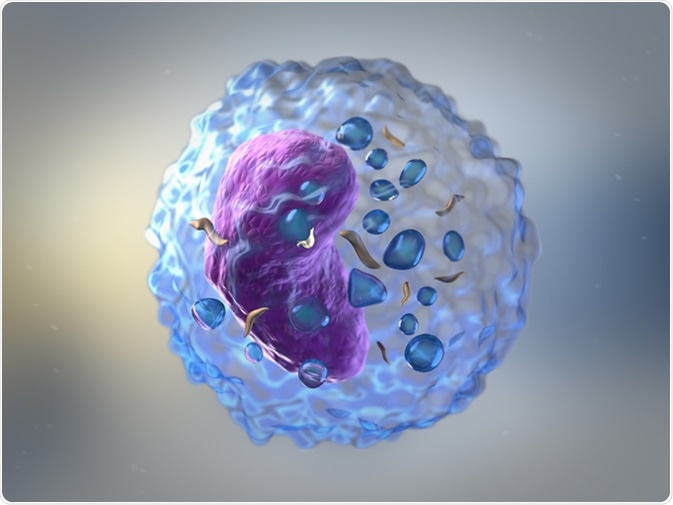Human Leukocyte Antigen (HLA)

Human leukocyte antigen (HLA) typing is important in organ transplantation protocols, as they determine the likelihood of rejection. The HLA system is little understood, however. In simple terms, the HLA genes are a family of genes which code for a set of proteins called the human leukocyte antigen complex.
They are related to each other structurally and functionally, and play a crucial role in enabling the body to recognize foreign proteins as such via the immune system, and to react to them appropriately.
The same function is carried out in other species by the MHC genes (the major histocompatibility complex). Thus, the HLA system is the human counterpart of the MHC genes, of which 200 occur, all located on the short arm of chromosome 6.
They derive their name from the fact that they were first identified because of the observation that clumped leukocytes showed an antigen-antibody reaction, between antibodies formed against the antigens present on the surface of human white blood cells.

This phenomenon was seen in women who had had repeated pregnancies or patients who had received multiple transfusions, and was found to be associated with a higher risk of graft rejection. However, despite their importance in this field, they are primarily active in the immunologic function of the human body.
Classes
The HLA/MHC genes are classified into three groups, I, II, and III:
- HLA/MHC class I genes comprise HLA-A, HLA-B and HLA-C. These encode cell surface proteins which bind peptides from within the cell, to display them to the patrolling immune cells. If the peptides are foreign in origin, the recognition by the immune system sets off an immune reaction which causes the destruction of the infected cell. Almost all cells with a nucleus have class I HLA molecules.
- HLA/MHC class II genes consist of HLA-DPA1, HLA-DQA1, HLA-DQB1, HLA-DRA and HLA-DRB1. They encode proteins which are usually on the cell surface of specific immune cells, to be recognized by other immune cells. These are found on B-lymphocytes, antigen-presenting cells such as dendritic cells and macrophages, and activated T-lymphocytes.
Both HLA-I and HLA-II genes have a structure which provides an antigen-binding groove on which processed peptides bind and are recognized.
- HLA/MHC class III genes produce proteins which play a part in inflammatory reactions, such as complement system components and tumor necrosis factors, and not HLA proteins. All the MHC gene products have not been characterized based on their function.
The genes of the HLA system have many possible alleles or variants in health. This great variation is confined to the antigen-binding area, which means the amino acids in various alleles form a slightly different shape each time. Thus, the immune system is primed to recognize and react to an almost infinite number of foreign antigens. Each allele is given a specific number, and then further variants are subclassified under this number, such as HLA-B27 and its subcategories HLA-B*2701, HLA-B*2702 and so on. The distribution of HLA antigens has a unique pattern among different ethnic populations.
Disease Associations
Many HLA alleles have been found to occur at a higher than average frequency in certain disease conditions, such as HLA-B27 in ankylosing spondylitis, though that does not mean that these gene products cause them. The inheritance of such disease tendencies is explained by the fact that these genes are typically linked in transmission, as a single package, from each parent to the offspring. Thus, the chances of having the same HLA haplotype are 25% in siblings, while they have a 50% chance of sharing half the set of HLA genes, and a 25% chance of being completely nonidentical.
Several components of the HLA class II region, especially the HLA-DRB1-DQA1–DQB1 haplotype, has been found to be associated with other autoimmune diseases, including type I diabetes mellitus, Graves’ disease or autoimmune hyperthyroidism, and rheumatoid arthritis.
MHC Restriction
The phenomenon called MHC restriction was described in 1974, when Zinkernagel and Dougherty showed that a T-lymphocyte must have the same MHC profile as the antigen-presenting cell if it is to react immunologically. This is because the antigenic peptide binds to the MHC complex on the cell surface, which can be recognized only by a T-lymphocyte carrying the corresponding receptor for that MHC complex.
Again, class I T-lymphocytes are CD8+ cells, which recognize antigens produced within and that are then exported from an infected or transformed cell. Class II T-cells are CD4+ cells, which recognize foreign antigens from outside the body which have been phagocytosed, processed and then exported in combination with the MHC complex to the cell surface.
Sources
- https://ghr.nlm.nih.gov/primer/genefamily/hla
- https://www.ncbi.nlm.nih.gov/pmc/articles/PMC2628004/
- www.msdmanuals.com/…/human-leukocyte-antigen-hla-system
- http://onlinelibrary.wiley.com/doi/10.1111/sji.12329/full
- https://www.ncbi.nlm.nih.gov/pmc/articles/PMC2647156/
Further Reading
- All Human Leukocyte Antigen Content
- What is the HLA System?
Last Updated: Feb 26, 2019

Written by
Dr. Liji Thomas
Dr. Liji Thomas is an OB-GYN, who graduated from the Government Medical College, University of Calicut, Kerala, in 2001. Liji practiced as a full-time consultant in obstetrics/gynecology in a private hospital for a few years following her graduation. She has counseled hundreds of patients facing issues from pregnancy-related problems and infertility, and has been in charge of over 2,000 deliveries, striving always to achieve a normal delivery rather than operative.
Source: Read Full Article